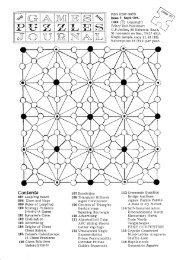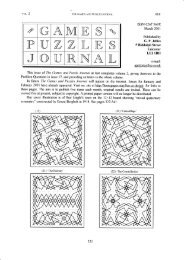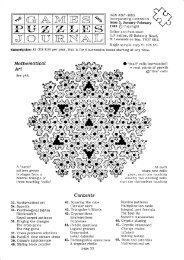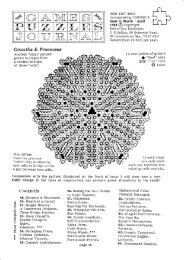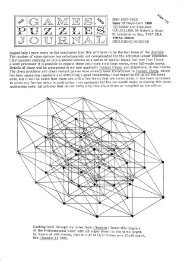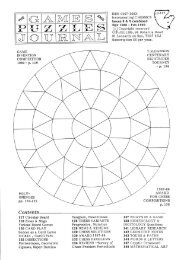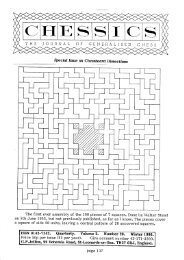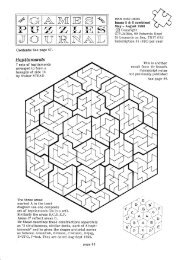The Games and Puzzles Journal, #15 - Mayhematics
The Games and Puzzles Journal, #15 - Mayhematics
The Games and Puzzles Journal, #15 - Mayhematics
You also want an ePaper? Increase the reach of your titles
YUMPU automatically turns print PDFs into web optimized ePapers that Google loves.
,O GAh.{ES AND PLIZZLES JO{.RhIAL<br />
RATIONAL MATHEMATICS<br />
by Professor Z.l. Cranium (Ivory Tower Institute of Technology)<br />
As noted in issue 13 &e editor has kindly allotted me an occasional page wherein I may ride some<br />
of my hobby horses; the principal of these is known as Finitism, which is essentially the belief that the<br />
concept of infinity' is unnecessary. In all practical applications il which infinity is used such as in the<br />
methods of differential <strong>and</strong> integral calculus, as customarily presented, it will be found that the concept<br />
is no longer present in the final results, as applied, <strong>and</strong> in fact it can be eliminated from the argument.<br />
Continuity. My rival, Doctor Owell of the Problematic Institute, has challenged me to define<br />
'continuity' within a finitist context. This I proceed to do.<br />
In many problems we encounter an 'ordered sst' or range of values X, from a 'first' value xo to a<br />
'last' value x, <strong>and</strong> between them a sequence of n - I values, which we can write as x,h, xz/,, ..., x1n_tyn,<br />
so that we can put xo : xo,o arrd x1 : xn/,.Thus there are n + I values in all in the range X {<strong>and</strong> n<br />
'intervals' between them).<br />
A range Y tlro;t contains all the values of a range X <strong>and</strong> others besides that are interposed between<br />
the values inXis said to be finer tkatX; or alternativelyXis said to be coarser than L<br />
A variable q thmit takes a succession of values ia a range X, passing through all values betweeir x,<br />
<strong>and</strong> r" in X, is said to vary continuously n X. lt will also vary continuously in any range coarser than<br />
X, but will not necessarily vary continuously in finer ranges.<br />
A variable that does not take certain values in a range, while taking values to either side of those<br />
not taken, is thus discontinuous in that range. A variable whose values are all separated by<br />
intermediate values that it does not take is termed a discrete variable. A discontinuous variable may be<br />
discrete for part of its range <strong>and</strong> continuous for the rest.<br />
If we are able to increase the accuracy of our measurements of a physical variable, by a more<br />
'microscopic' study, it may be that the variable that we have prwiously been able to treat as continuous<br />
now becomes discrete. This, for example, is the case with the density of a liquid which is a continuous<br />
variable provided it is determined for volume units considerably greater than that of &e individual<br />
molecules of the material. (A cubic centimetre of water contains more than 10?2 molecules.)<br />
Conversely, if we consider a particular system from a more 'macroscopic' point of view, ttrat is<br />
disregarding finer details, then a variable ttrat we have treated as discrete may become continuous.<br />
Aecuracy. One of the practices that armoys me considerably is to see quantities cited without any<br />
indication of the degree of accuracy claimed for them. One of the figures currently b<strong>and</strong>ied about is that<br />
of the Age of the Universe, which is said to have begun, at the 'big bang' 15, 000 million years ago.<br />
(Patrick Moore, Atlas of fhe Universe 1994, p.190 - is only one of many references that could be<br />
cited.) How accurate is this figure? To the nearest million? <strong>The</strong> nearest thous<strong>and</strong> million? <strong>The</strong> nearest<br />
5000 million? If it is that inaccurate, does it really have any meaning at all?<br />
Are Calendars Full of Holes? On an entirely different subject: I've been thinking about calendars<br />
receirtly <strong>and</strong> began looking up a few terms in <strong>The</strong> Chambers Dicfionary (1993 edition) to try to clarify<br />
my ideas. <strong>The</strong>re I found 'summer' defined as "the warmest season of the year; the period between the<br />
srunmer solstice <strong>and</strong> the autumn equinox". Howwer, 'mid-summer' is defined as 'the middle of the<br />
surnmer; the summer solstice, occurring about 2l June in the Northern Hemisphere." Am I confused or<br />
is Chambers? Can something start in the middle?<br />
In case I was seeing things I also checked up on 'winter': "the cold season of the year, in northern<br />
temperate regions, from November or Decernber to January or February; astronomically, from the<br />
winter solstice to the vemal equinox" <strong>and</strong> 'midwinter': "the middle of winter; the winter solstice,<br />
occurring about 22 December in the northern hemisphere."<br />
<strong>The</strong> same self-contradictory nonsense appears in the Concise Oxford Dictionary (1978 edition,<br />
admittedly out of date). Can anyone resolve this qu<strong>and</strong>ary for me?<br />
268




